Service Alert
Le 1 juillet, Fête du Canada
À l’occasion de la Fête du Canada, le CAÉB sera fermé le mardi 1 juillet. Les heures d’opération régulières reprendront le mercredi 2 juillet. Nous vous souhaitons un bon congé!
À l’occasion de la Fête du Canada, le CAÉB sera fermé le mardi 1 juillet. Les heures d’opération régulières reprendront le mercredi 2 juillet. Nous vous souhaitons un bon congé!
Articles 81 à 100 sur 1499734
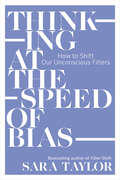
Par Sara Taylor. 2024
A practical guide to tackling unconscious bias in a polarized world.Learn to recognize your unconscious bias and create positive change.Respected…
DEI expert Sara Taylor presents a down-to-earth guide on how to tackle unconscious biases and foster true equity in our rapidly changing world. Through relatable examples and practical strategies, readers learn to deliberately slow down their thought processes and become aware of their filters in various situations. Taylor encourages readers to question their own assumptions by asking, "Do I know that what I'm thinking is actually true?" and "Why might I be reacting this way?"The book demonstrates the importance of a clear set of competencies, skills, and strategies for addressing unconscious bias. By developing a culturally competent mindset and using a shared, holistic language to discuss these issues, readers gain the tools to understand, discuss, and implement change both at home and in the workplace. This approach avoids blame or shame, making it accessible and empowering for everyone.The book's insights extend beyond individuals; it demonstrates how organizations can scale up cultural competence to transform their structures and systems. With a strong sense of hope, readers are empowered to make a difference, creating a more just and equitable world for all.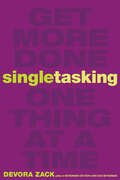
Par Devora Zack. 2015
Your Mind Can't Be Two Places at OnceToo many of us have become addicted to the popular, enticing, dangerously misleading…
drug of multitasking. Devora Zack was once hooked herself. But she beat it and became more efficient, and you can too. Zack marshals convincing neuroscientific evidence to prove that you really can't do more by trying to tackle several things at once—it's an illusion. There is a better way to deal with all the information and interruptions that bombard us today. Singletasking explains exactly how to clear and calm your mind, arrange your schedule and environment, and gently yet firmly manage the expectations of people around you so that you can accomplish a succession of tasks, one by one—and be infinitely more productive. Singletasking is the secret to success and sanity.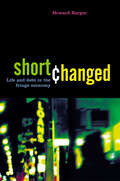
Par Howard Jacob Karger. 2005
Drive through just about any low-income neighborhood and you're sure to see streets lined with pawnshops, check cashers, rent-to-own stores,…
payday and tax refund lenders, auto title pawns, and buy-here-pay-here used car lots. We're awash in "alternative financial services" directed at the poor and those with credit problems. Howard Karger describes this world as an economic Wild West, where just about any financial scheme that's not patently illegal is tolerated. Taking a hard look at this fringe economy, Karger shows that what seem to be small, independent storefront operations are actually part of a fully-formed parallel economy dominated by a handful of well-financed corporations, subject to little or no oversight, with increasingly strong ties to mainstream financial institutions. "It is a hidden world," Karger writes, "where a customer's economic fate is sealed with a handshake, a smile, and a stack of fine print documents that would befuddle many attorneys." Filled with heartbreaking stories of real people trapped in perpetual debt, Shortchanged exposes the deceptive practices that allow these businesses to prey on people when they are most vulnerable. Karger reveals the many ways this industry has run amok, ruining countless people's lives, and shows that it's not just the poor but, more and more, maxed-out middle class consumers who fall prey to these devious schemes. Balancing compassion with a realistic awareness of the risks any business faces in working with an economically distressed clientele, Karger details hard headed, practical recommendations for reforming this predatory industry.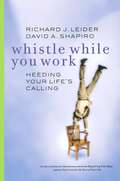
Par Richard J. Leider, David Shapiro. 2001
Everyone wants to live a life that enables them to make the most of their unique gifts, interests, and passions-to…
find their true calling, the work they were born to do. Whistle While You Work is a liberating guide that uses powerful stories and exercises to help readers find truly satisfying, fulfilling work consistent with their deepest values. The authors combine a thoughtful and practical discussion about calling with examples showing how to apply these ideas to one's life. They mix in dozens of inspiring stories featuring individuals who have found, or are in the process of finding, their calling with straightforward advice and suggestions on how to discover one's calling. Most importantly, they provide readers with a solid path for embracing calling, a subject usually addressed abstractly in a useful, fun, and systematic way. Through a unique Calling Card exercise that features a guided exploration of 52 "natural preferences" -- such as Advancing Ideas, Doing the Numbers, Building Relationships, Performing Events -- the book gives readers a new way to detect and reflect on the core of their life's work. By using this and other tools in the book, readers develop their own answers to three critical questions: What gift do I naturally give to others? What gift do I most enjoy giving to others? What gift have I most often given to others? In answering those questions, they will reveal to themselves their calling-and ultimately move toward new realms of success and fulfillment. Whistle While You Work is an inspiring, effective, and entertaining approach to discovering one's calling. It will equip all of us with the mind-set, stories, coaching, and, perhaps most importantly, the hope we need to find our way ahead-and see a clear picture of what our right work is and what to do with our limited time here on Earth.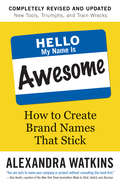
Par Alexandra Watkins. 2019
The ultimate guide to naming your product or business has been updated throughout with twice as many resources as before,…
new stories (of both hits and flops), and an entirely new chapter on the power of names in the workplace.Too many new companies and products have names that look like the results of a drunken Scrabble game (Xobni, Svbtle, Doostang). In this entertaining and engaging book, ace-naming consultant Alexandra Watkins explains how anyone—even noncreative types—can create memorable and effective brand names. No degree in linguistics required.The heart of the book is Watkins's proven SMILE and SCRATCH Test. A great name makes you SMILE because it is Suggestive—evokes something about your brand; is Memorable—makes an association with the familiar; uses Imagery—aids memory through evocative visuals; has Legs—lends itself to a theme for extended mileage; and is Emotional—moves people. A bad name, on the other hand, makes you SCRATCH your head because it is Spelling challenged—looks like a typo; is a Copycat—similar to competitors' names; is Restrictive—limits future growth; is Annoying—seems forced and frustrates customers; is Tame—feels flat, merely descriptive, and uninspired; suffers from the Curse of Knowledge—speaks only to insiders; and is Hard to pronounce—confuses and distances customers.This 50 percent–new second edition has double the number of brainstorming tools and techniques, even more secrets and strategies to nab an available domain name, a brand-new chapter on how companies are using creative names around the office to add personality to everything from cafeterias to conference rooms, and much more.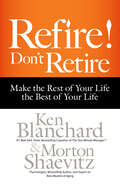
Par Ken Blanchard, Morton Shaevitz. 2015
Refire! Don't Retire asks readers the all-important question: as you look at the years ahead, what can you do to…
make them satisfying and meaningful? Ken Blanchard and Morton Shaevitz point out that some people see their later years as a time to endure rather than as an exciting opportunity. Both research and common sense confirm that people who embrace these years with energy and gusto—rather than withdrawing and waiting for things to happen—consistently make the rest of their lives the best of their lives.In the trademark Ken Blanchard style, the authors tell the compelling story of Larry and Janice Sparks, who discover how to see each day as an opportunity to enhance their relationships, stimulate their minds, revitalize their bodies, and grow spiritually. As they learn to be open to new experiences, Larry and Janice rekindle passion in every area of their lives. Readers will find humor, practical information, and profound wisdom in Refire! Don't Retire. Best of all, they will be inspired to make all the years ahead truly worth living.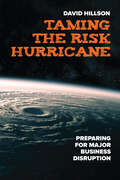
Par David Hillson. 2022
A leading expert on risk management describes how to steer your company through a risk hurricane-the extreme risk exposure that…
can lead to major disruption for your business.Risk management has become a standard part of the strategic tool kit, providing senior leaders with a forward-looking radar to scan the future and give early warnings of approaching threats and opportunities. However, even best-in-class organizations can falter in the face of extreme risk exposure. Special circumstances demand special responses, and extreme risk exposure needs very careful handling. Routine risk management approaches will fall short, but businesses that demonstrate a high degree of flexibility and resilience will have the competitive advantage and the ability to thrive where others fail.The causes and consequences of meteorological hurricanes have parallels in the way uncontrolled risk exposure can develop in organizations. Both are caused largely by predictable factors, but both are characterized by sustained uncertainty and severe impact once they develop. If we can learn to predict a risk hurricane, prepare for it effectively, and survive its effects, then our organizations will be well placed to address the challenge of extreme risk exposure, if and when we are unfortunate enough to face it.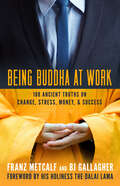
Par Franz Metcalf, Bj Gallagher. 2012
Buddhism has for thousands of years provided a spiritual foundation for the daily lives of millions of people around the…
world. But does Buddhism have anything to offer us—Buddhists and non-Buddhists alike—in today’s world of work? Metcalf and Gallagher think it does. Spiritual wisdom, Western or Eastern, inspires and instructs us in living a good life. And that’s just as true at work as at home. Buddha mind—a source of calm, compassion, and insight—exists within each of us, not just the historical Buddha. Being Buddha at Work shows how to embody that mind in the stress and clamor of the workplace—how to tap into the Buddha consciousness so we can relieve daily tensions and greet challenges with awareness, equanimity, and good humor. The book is divided into three sections. The first, “Becoming a Mindful Worker,” covers Buddha’s wisdom for our own work; the second, “Cultivating Mindful Work Relationships,” focuses on how to work with other people; the third, “Creating a Mindful Workplace,” deals with broader organizational topics. There is wisdom here for everyone—from frontline workers and team members, to supervisors and managers, to top executives and organizational leaders.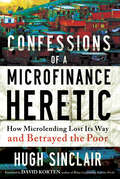
Par Hugh Sinclair. 2012
Very little solid evidence exists that microloans make a dent in long-term poverty. Sadly, evidence does exist for negligence, corruption,…
and methods that border on extortion. Part exposé, part memoir, and part financial detective story, this is the account of a one-time true believer whose decade in the industry turned him into a heretic. Hugh Sinclair worked with several microfinance institutions around the world. He couldn’t help but notice that even with a booming $70 billion industry on their side, the poor didn’t seem any better off. Exorbitant interest rates led borrowers into never-ending debt spirals, and aggressive collection practices resulted in cases of forced prostitution, child labor, suicide, and nationwide revolts against the microfinance community. Sinclair weaves a shocking tale of a system increasingly focused on maximizing profits—particularly once large banks got involved. He details his discovery of several scandals, one of the most disturbing involving a large African microfinance institution of questionable legality that charged interest rates in excess of 100 percent per year and whose investors and supporters included some of the most celebrated leaders of the microfinance sector. Sinclair’s objections were first met with silence, then threats, attempted bribery, and a court case, and eventually led him to become a principal whistleblower in a sector that had lost its soul. Microfinance can work—Sinclair describes moving experiences with several ethical and effective organizations and explains what made them different. But without the fundamental reforms that Sinclair recommends here, microfinance will remain an “investment opportunity” that will leave the poor with hollow promises and empty pockets.
Par Judith H. Katz, Frederick A. Miller. 1985
Constant, continuing, and cataclysmic change is causing a major crisis within business organizations today. Faced with constantly advancing technology, unpredictable…
market shifts, intense global competition, and an increasingly independent "free agent" workforce, the only way for an organization to adapt and succeed is to build a "culture of inclusion" that nurtures and draws on the talents of a diverse workforce. Easy to say but hard to do; most organizations are mired in industrial revolution, static-world business models administered by monocultural, bordering-on-oppressive, "command and control" hierarchies. Organizations at risk include Fortune 500 giants, entrepreneurial start-ups, manufacturing and retail operations, government agencies, not-for-profits, educational institutions, and others. Most organizational change efforts-whether labeled as diversity efforts, re-engineering, right-sizing, or total-quality-management-are a waste of time, money, and human effort. Most produce more cynicism than results, and they can poison the waters for future change efforts. The Inclusion Breakthrough cuts a path through this potential minefield, offering a proven methodology for strategic organizational change, including models for diagnosing, planning, and implementing inclusion-focused, culture-change strategies tailored to each organization's individual needs. It also describes the key competencies for leading and sustaining a culture of inclusion. Offering real-world results of "before and after" surveys, including anecdotal and statistical reports of organizational change achieved using the methodologies described, The Inclusion Breakthrough presents an overview of current workplace conditions, attitudes, and policies based on interviews, surveys, and focus groups encompassing thousands of people in major organizations. The Inclusion Breakthrough demonstrates why the bottom line must be the central focus of any change strategy-and more importantly, how to carry that strategy out successfully.
Par Rob Dietz, Daniel W. O’Neill. 2012
It’s time for a new kind of economy We’re overusing the earth’s finite resources, and yet excessive consumption is failing…
to improve our lives. In Enough Is Enough, Rob Dietz and Dan O’Neill lay out a visionary but realistic alternative to the perpetual pursuit of economic growth—an economy where the goal is not more but enough. They explore specific strategies to conserve natural resources, stabilize population, reduce inequality, fix the financial system, create jobs, and more—all with the aim of maximizing long-term well-being instead of short-term profits. Filled with fresh ideas and surprising optimism, Enough Is Enough is the primer for achieving genuine prosperity and a hopeful future for all. “Humans seem to be intent on confirming the argument of biologist Ernst Mayr that higher intelligence may be a lethal mutation. But the grim prognosis is not inevitable. This lucid, informed, and highly constructive book shows that with the will to act, solutions can be found to build a steady-state economy geared to meeting human needs.” —Noam Chomsky “Rob Dietz and Dan O’Neill bring clarity and style to their impassioned and meticulous analysis, offering the way to a better quality of life and a sustainable future for all.” —Kate Pickett, Professor of Epidemiology, University of York; cofounder, The Equality Trust; and coauthor of The Spirit Level “Dietz and O’Neill create a remarkable vision—a world with enough prosperity and happiness for everyone, not just for a few. This book will restore your hope in the future and give you specific things you can do to help!” —Thom Hartmann, internationally syndicated talk show host and author of twenty-four books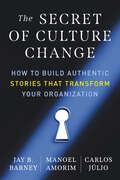
Par Jay B. Barney, Manoel Amorim, Carlos Júlio. 2023
Find out how bold actions by visionary leaders can inspire powerful stories that drive culture change.Data indicates that most strategic…
efforts to change a company's culture fail. So how do companies succeed in this endeavor? A top strategy professor and two highly successful CEOs found that, in companies that had successfully changed their culture, leaders had taken dramatic actions that embodied the new cultural values. These actions inspired stories that became company legends, repeated in every department and handed on to new employees. Through compiling and analyzing 150 stories from business leaders who have achieved change, they identified 6 attributes that every successful culture change story has in common:1. The actions are authentic2. They revolve around the CEO3. They signal a clean break with the past, and a clear path to the future4. They appeal to employee heads and hearts5. They're often theatrical or dramatic6. They're told, and re-told, throughout the organizationWith extensive and inspiring examples of stories containing these attributes, the authors illustrate how readers can harness the power of stories within their company in order to change or create a winning culture to align with any strategy.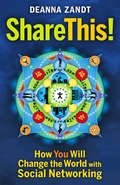
Par Deanna Zandt. 2010
Shows how both activists and the casually progressive can leverage the power of social networks for social change Helps readers…
maintain credibility, establish new connections, deal with common fears, and have a good time Authoritative but aggressively non-technical—like talking to a real person with a great sense of humor who really knows her stuff Social networks can be so much more than a way to find your high school friends or learn what your favorite celebrity had for breakfast. They can be powerful tools for changing the world. With Share This! both regular folks of a progressive bent and committed activists can learn how to go beyond swapping movie reviews and vacation photos (not that there’s anything wrong with that). At the moment the same kinds of people who dominate the dialog off-line are dominating it online, and things will never change if that doesn’t change. Progressives need to get on social networks and share their stories, join conversations, connect with others—and not just others exactly like themselves. It’s vital to reach out across all those ethnic/gender/preference/class/age lines that exist even within the progressive camp. As Deanna Zandt puts it, “creating a just society is sort of like the evolution of the species—if you have a bunch of the same DNA mixing together the species mutates poorly and eventually dies off.” But there are definitely dos and don’ts. Zandt delves into exactly what people are and are not looking for in online exchanges. How to be a good guest. What to share. Why authenticity is more important than just about anything, including traditional notions of expertise or authority. She addresses some common fears, like worrying about giving too much about yourself away, blurring the lines between your professional and personal life, or getting buried under a steaming heap of information overload. And she offers detailed, nuts-and bolts “how to get started” advice for both individuals and organizations. The Internet is upending hierarchies and freeing the flow of information in a way that makes the invention of the printing press seem like an historical footnote. Share This! shows how to take advantage of this unprecedented opportunity to make marginalized voices heard and support real, fundamental change—and, incidentally, have some fun doing it.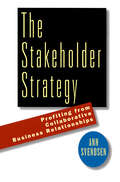
Par Ann Svendsen. 1998
In today's highly networked and competitive global economy, mounting social and environmental problems are forcing corporations to focus on more…
than just their stockholders' interest in meeting bottom line profitability. More and more companies are recognizing the value of identifying and building relationships with all of their organization's stakeholders-employees, customers, suppliers, and even communities. In fact, recent research has shown that companies that treat their employees well, create jobs in the local economy, develop innovative products and services, take care of the environment, and contribute to the community, are often more profitable. In The Stakeholder Strategy, sociologist Ann Svendsen presents an effective and practical step-by-step guide that companies can use to forge a network of powerful and profitable collaborative stakeholder relationships. While some forward-thinking corporations have tried limited collaborative approaches-focusing on one stakeholder group at a time-few have taken a comprehensive and strategic approach to building relationships with all of their stakeholders, notes Svendsen. And, while considerable commitment to the idea of stakeholder collaboration exists, there is a lack of knowledge and understanding about how to develop these relationships. The Stakeholder Strategy is the first book to show business leaders and managers how to establish and maintain positive, mutually beneficial stakeholder relationships. Based on a synthesis of ideas from community relations, corporate philanthropy, stakeholder management, organizational change, sustainability, and the corporate social responsibility literature, it offers an integrated framework, as well as the practical tools for developing new kinds of collaborative relationships. Svendsen uses easy-to-grasp concepts from everyday life, such as the process we go through in finding a mate or developing a long-term friendship, to illustrate these relationship-building strategies. She lays out the steps a company should take to create a collaboration-friendly organization: establishing a social mission, values, and ethical guidelines; assessing corporate readiness for collaboration; and making changes in communication, information and reward systems to support internal and external collaboration. Featuring case study examples from companies in North America and Europe who are working to build collaborative relationships with their stakeholders, The Stakeholder Strategy is the first book to provide a detailed explanation of how to conduct stakeholder audits and social audits so that companines can evaluate their relationship-building success and keep on track.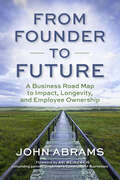
Par John Abrams. 2025
Learn how to transition leadership, implement shared ownership, and preserve your organization's core values-setting the stage for your business to…
thrive for generations to come.This visionary but practical handbook offers mission-driven business owners a roadmap for ensuring their company's lasting impact, building leadership internally, and fostering participatory management.Through inspiring real-world stories of B-Corps, worker co-ops, ESOPs, and employee ownership trusts, this book demonstrates how to create resilient organizations that benefit workers and communities.Drawing on his 50-year journey with South Mountain Company and extensive research, Abrams outlines five critical transitions for mission-driven businesses to become what he calls a CommonWealth company:• From founder to next-generation leadership• From sole ownership to widely shared• From hierarchical control to democratic management• From unprotected mission to preserved purpose• From business-as-usual to B Corp force for goodFrom Founder to Future is an essential guide for mission-driven leaders seeking to reshape their businesses for inclusivity, longevity, and positive impact. Whether you're a retiring owner planning your exit, a young entrepreneur building for the future, or an employee working in a purpose-driven business, this book offers a blueprint for creating enduring, values-driven enterprises in the emerging regenerative economy. As 3,000,000 U.S. small business founders over 55 prepare to retire, $10 trillion in assets will change hands over the next two decades. This timely guide shows how to preserve your company's mission and legacy while empowering the next generation.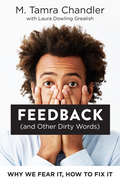
Par M. Tamra Chandler, Laura Dowling Grealish. 2019
A practical and irreverent guide to taking the sting out of feedback and reclaiming it as a motivating, empowering experience…
for everyone involved. Feedback: the mere mention of the word can make our blood pressure rise and our defenses go up. For many of us, it's a dirty word that we associate with bias, politics, resentment, and self-doubt. However, if we take a step back and think about its true intent, we realize that feedback needn't be a bad thing. After all, understanding how others experience us provides valuable opportunities to learn and grow. Authors M. Tamra Chandler and Laura Grealish explain how feedback got such a bad rap and how to recognize and minimize the negative physical and emotional responses that can erode trust and shut down communication. They offer a new and more ambitious definition of feedback, explore the roles we each play as Seeker, Extender, and Receiver, and introduce the three Fs of making feedback focused, fair, and frequent. You'll also find valuable exercises and strategies, along with real-world examples that illustrate how you can put these ideas into action and join in the movement to fix feedback, once and for all.When it's done right, feedback has been proven to be the most effective means of improving communication and performance for you and your organization. It's too important to give up, and with Chandler and Grealish's help, you'll be able to use it deftly, equitably, and effectively.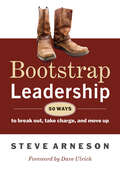
Par Steve Arneson. 2010
Arneson was named one of America’s top leadership consultants by Leadership Excellence magazine in 2008 Enables leaders at all levels…
to design a complete self-directed leadership development program Concise, accessible, practical and flexible Leadership training can be inconsistent in the best of times. In tough economic times it’s often one of the first things that even the most progressive companies cut back on. And you can’t necessarily depend on finding that mentor you’ve been looking for either. Now more than ever, if you’re going to advance your career you need to lift yourself up by your own bootstraps. But not entirely: Steve Arneson is here to give you a boost. In Bootstrap Leadership Arneson, one of America’s top leadership coaches, offers a complete blueprint for designing your own personal leadership development program. In fifty brief, to-the-point chapters he provides practical ideas and techniques that have been proven successful in his work with executives at Fortune 500 companies like AOL, PepsiCo and Capital One. Surprisingly, most of these ideas cost nothing to implement, nor do they require any elaborate equipment or infrastructure—they’re open to anyone with sufficient initiative, drive and ambition. The chapters are entirely self-contained and can be read in any order and at any pace. You can read one a week and you’ll have a comprehensive year-long self-improvement program (with two weeks off for vacation). Or you can choose a chapter that speaks to a particular challenge you’re facing at work or one that just seems intriguing. There’s a self-assessment at the beginning of the book to suggest specific chapters that fit your developmental needs. No one is going to just hand that next promotion. You have to earn it by developing and demonstrating your leadership skills. And ultimately it’s not just about you—true leaders make everyone around them better. Bootstrap Leadership shows you how.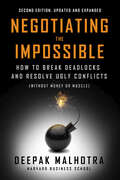
Award-winning professor from Harvard Business School offers a new and improved edition of his guide to navigating negotiation deadlock, while…
offering practical advice and stories of success.Updated with 20% new material, including a brand-new chapter and discussion guide.Harvard professor and negotiation adviser Deepak Malhotra shows how to defuse even the most potentially explosive situations and to find success when things seem impossible in this fully expanded upon second edition.Some negotiations are easy. Others are more difficult. And then there are situations that seem completely hopeless. Malhotra identifies three broad approaches for breaking deadlocks and resolving conflicts, and draws out scores of actionable lessons using behind-the-scenes stories of fascinating real-life negotiations, including:• drafting of the US Constitution• ending bitter disputes in the NFL and NHL• and beating the odds in complex business situations.He also shows how these same principles and tactics can be applied in everyday life, whether in a job interview or even negotiating with children. Brand new to this edition is a chapter on challenges facing today's world including how to effectively negotiate in virtual spaces, incorporate AI in your toolkit, and tackle increased polarization.With conflict escalating and no one willing to back down, Malhotra reminds us that negotiation is always, fundamentally, about human interaction. No matter how high the stakes the object of negotiation is to engage with other human beings in a way that leads to better understandings and agreements. The principles and strategies in this book will help you do this more effectively in every situation.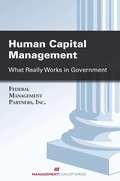
Par Federal Management Partners, Inc.. 2014
Many federal agencies have made huge strides to develop, fully utilize, and enhance the effectiveness of their most valuable resource:…
their workforce. This book captures those successes and relates the stories behind them. Innovative recruitment and retention strategies, dynamic employee onboarding programs, leading-edge HR technology—these are some of the stories that offer valuable lessons for anyone dealing with human resources issues in government, business, or any other organizational environment. The authors highlight not only the successful outcomes of various agency programs, but also consider the bumps and hurdles encountered and overcome along the way. Rather than a theoretical presentation of what might, or should, work, Human Capital Management: What Really Works in Government provides thought-provoking and practical examples detailing what federal agencies are doing that is working.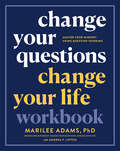
Par Marilee Adams, Andrea F. Lipton. 2022
Based on the bestseller Change Your Questions, Change Your Life, this workbook is a practical guide that helps readers ask…
the right questions for successful change. In the bestselling classic, Change Your Questions, Change Your Life, Dr. Marilee Adams introduces Question Thinking, which shows how you can change your questions and your mindset for the most successful outcomes. This workbook puts those original ideas into action and makes them easy to implement. In this workbook you get to choose an area of your life that you want to improve and then apply the principles and practices of Question Thinking to experience the benefits of this system firsthand. At the center of this work is the Choice Map, which helps you recognize the likely impact of the questions you ask. This book provides tools, warm-up exercises, somatic practices, and learning scenarios that bring the practical applications of Question Thinking into your professional and personal life. Thoroughly engaging, it includes how the Question Thinking protocols can help you switch from a controlling Judger Mindset to a flexible Learner mindset and learn how to facilitate more effective meetings and conversations. Although this workbook can serve as a companion to the bestselling book, it has been designed to stand on its own. In the book, the fable's hero undergoes a transformative journey by using Question Thinking, and this workbook helps readers undergo a similar transformation.